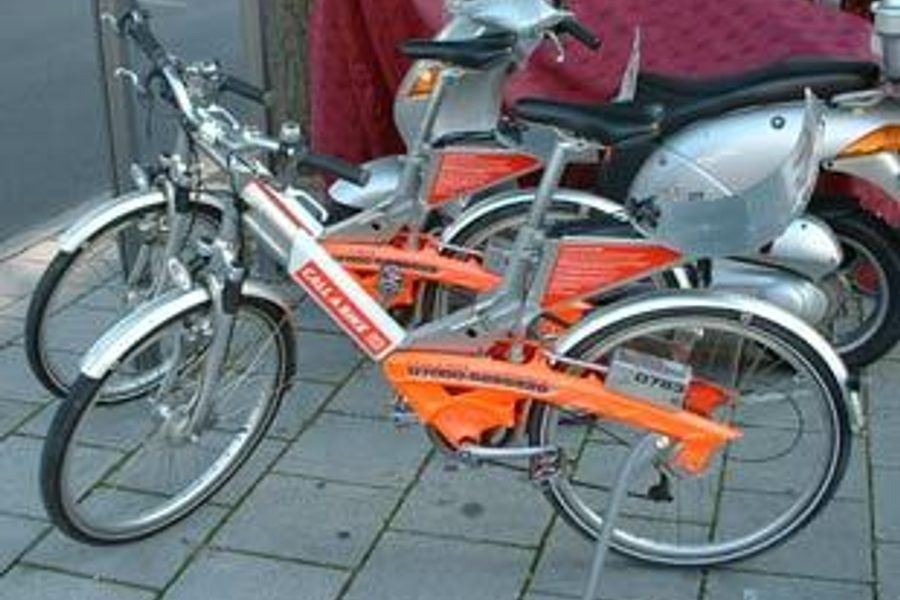Bike-Sharing Is Caring
Bike-sharing programs that provide cheap access to inner-city bicycles are popular all over Europe, and Beijing, and even American cities are catching on
Adam Doster

While working the graveyard shift in a University of Virginia computer lab 13 years ago, Paul DeMaio had dreams of the open road. On a whim, the avid cyclist and environmentalist entered “public bikes” into a search engine and discovered images of Bycyklen, Copenhagen’s then-new bike-sharing service. One glimpse and DeMaio was hooked. “The idea just blew me away,” he says. “This was it.”
DeMaio arranged to study in Denmark, where he absorbed as much about bike-sharing culture as possible. Convinced that the idea would appeal to Americans, he created MetroBike LLC, a bicycle planning and bike-sharing consulting company based in Washington D.C. And now, more and more cyclists and legislators are turning their attention to DeMaio’s cause. “We’ve come a long way,” he says. “Bike-sharing really has gotten a lot of attention.”
Essentially, bike-sharing programs provide cheap access to bicycles, mostly for inner-city transportation. In the late ’60s, some Europeans placed donated bikes across cities like Amsterdam and Milan for residents to ride free of charge, hoping to provide citizens with an ecologically friendly mode of travel. But vandalism and theft sank nearly all of the early campaigns. Today, technology – such as electronic payment, tracking and locking systems – has helped reduce crime and revive bike-sharing efforts worldwide.
The Vélib in Paris, a new venture owned and operated by the city but co-financed by the JCDecaux advertising corporation in exchange for exclusive rights to on-street advertising, has quickly become the most comprehensive and successful bike-sharing program in the world. Socialist Mayor Bertrand Delanoe launched the Vélib in July by placing 10,000 bicycles at 750 stations throughout the city. For a small credit card fee (29 euros a year, or about $43), Parisians can swipe the card at any bike rack, grab an available two-wheeler, ride it across town and leave it for others at their new destination. Bike rental is free for the first 30 minutes, which accounts for 80 percent of all rides, and only a marginal cost for each additional half-hour. Officials intend to double the fleet by 2008 as more than 6 million rides were recorded in the first three months, with every bike being rented an average of 10 times a day, according to a report in BusinessWeek.
While the Vélib is the largest program to date, Paris is not alone in its cycling enthusiasm. Various cities across the globe have implemented successful bike-sharing systems in recent years, including Barcelona, Stockholm and Berlin. Beijing, known as the Kingdom of Bicycles, recently unveiled plans to unleash 50,000 bikes in time for the 2008 Olympics.
Bike-sharing fever has even spread to the United States, a country lacking a robust bike culture but one where car-sharing has thrived and biking is becoming more mainstream. In San Francisco, the city Board of Supervisors is set to vote on a contract with Clear Channel Outdoor Inc. that would establish a bike-sharing program in return for advertising rights on transit shelters. Chicago Mayor Richard Daley visited Paris in September to test the Vélib in action and is considering a similar program for the Windy City. New York City, Portland and Washington, D.C. officials have also expressed interest.
Margo O’Hara, communications director for the Chicagoland Bicycle Federation, points out that reducing dependency on the automobile – and the carbon emissions, pollution, and traffic it creates – is the most obvious attribute of bike-sharing, but a well-designed system has other virtues. “The cool thing about bicycling,” she says, “is that it’s public. You’re able to talk to people on your commute to work, as opposed to being in this confined vacuum of a car.” Bike-sharing also provides a cheap, sustainable appendage to under-funded and overcrowded mass transit systems. “Bike-sharing is not going to replace bus or rail transit,” says DeMaio, “but it’s really complimentary … because it does extend these other modes of transit’s reach.”
Bike-sharing certainly isn’t perfect. Safety is a concern, especially in cities lacking bike-friendly infrastructure. Helmets are generally not provided with a rental, and theft, while complicated by user electronic identification, still poses a financial risk.
There’s also the possibility that people who could benefit from such services – namely, low-income people who need reliable transportation but have problems affording it – will not be served, especially in cities like Chicago and Washington, D.C. that are highly segregated, both economically and racially. DeMaio stresses that, for the programs to be most effective, local legislators must distribute bike-sharing resources equitably. “It’s up to the government to ensure that the stations are placed in underserved neighborhoods,” he says, “to ensure that people of all backgrounds … have access to this mode of transit.”
But those are small concerns for an overwhelmingly popular movement. “I think the demand is there,” says O’Hara. “And you can see in Chicago: The more acceptable it is to bike, the more people bike.”






